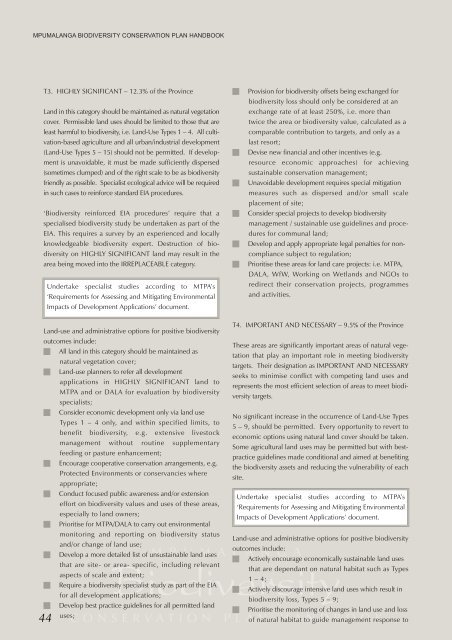Mpumalanga Biodiversity Conservation Plan Handbook - bgis-sanbi
Mpumalanga Biodiversity Conservation Plan Handbook - bgis-sanbi
Mpumalanga Biodiversity Conservation Plan Handbook - bgis-sanbi
Create successful ePaper yourself
Turn your PDF publications into a flip-book with our unique Google optimized e-Paper software.
MPUMALANGA BIODIVERSITY CONSERVATION PLAN HANDBOOK<br />
T3. HIGHLY SIGNIFICANT – 12.3% of the Province<br />
Land in this category should be maintained as natural vegetation<br />
cover. Permissible land uses should be limited to those that are<br />
least harmful to biodiversity, i.e. Land-Use Types 1 – 4. All cultivation-based<br />
agriculture and all urban/industrial development<br />
(Land-Use Types 5 – 15) should not be permitted. If development<br />
is unavoidable, it must be made sufficiently dispersed<br />
(sometimes clumped) and of the right scale to be as biodiversity<br />
friendly as possible. Specialist ecological advice will be required<br />
in such cases to reinforce standard EIA procedures.<br />
‘<strong>Biodiversity</strong> reinforced EIA procedures’ require that a<br />
specialised biodiversity study be undertaken as part of the<br />
EIA. This requires a survey by an experienced and locally<br />
knowledgeable biodiversity expert. Destruction of biodiversity<br />
on HIGHLY SIGNIFICANT land may result in the<br />
area being moved into the IRREPLACEABLE category.<br />
Undertake specialist studies according to MTPA’s<br />
‘Requirements for Assessing and Mitigating Environmental<br />
Impacts of Development Applications’ document.<br />
Land-use and administrative options for positive biodiversity<br />
outcomes include:<br />
All land in this category should be maintained as<br />
44<br />
natural vegetation cover;<br />
Land-use planners to refer all development<br />
applications in HIGHLY SIGNIFICANT land to<br />
MTPA and or DALA for evaluation by biodiversity<br />
specialists;<br />
Consider economic development only via land use<br />
Types 1 – 4 only, and within specified limits, to<br />
benefit biodiversity, e.g. extensive livestock<br />
management without routine supplementary<br />
feeding or pasture enhancement;<br />
Encourage cooperative conservation arrangements, e.g.<br />
Protected Environments or conservancies where<br />
appropriate;<br />
Conduct focused public awareness and/or extension<br />
effort on biodiversity values and uses of these areas,<br />
especially to land owners;<br />
Prioritise for MTPA/DALA to carry out environmental<br />
monitoring and reporting on biodiversity status<br />
and/or change of land use;<br />
outcomes include:<br />
M P U M A L A N G A<br />
Develop a more detailed list of unsustainable land uses<br />
<strong>Biodiversity</strong><br />
that are site- or area- specific, including relevant<br />
aspects of scale and extent;<br />
Require a biodiversity specialist study as part of the EIA<br />
for all development applications;<br />
Develop best practice guidelines for all permitted land<br />
uses;<br />
Provision for biodiversity offsets being exchanged for<br />
biodiversity loss should only be considered at an<br />
exchange rate of at least 250%, i.e. more than<br />
twice the area or biodiversity value, calculated as a<br />
comparable contribution to targets, and only as a<br />
last resort;<br />
Devise new financial and other incentives (e.g.<br />
resource economic approaches) for achieving<br />
sustainable conservation management;<br />
Unavoidable development requires special mitigation<br />
measures such as dispersed and/or small scale<br />
placement of site;<br />
Consider special projects to develop biodiversity<br />
management / sustainable use guidelines and procedures<br />
for communal land;<br />
Develop and apply appropriate legal penalties for non-<br />
compliance subject to regulation;<br />
Prioritise these areas for land care projects: i.e. MTPA,<br />
DALA, WfW, Working on Wetlands and NGOs to<br />
redirect their conservation projects, programmes<br />
and activities.<br />
T4. IMPORTANT AND NECESSARY – 9.5% of the Province<br />
These areas are significantly important areas of natural vegetation<br />
that play an important role in meeting biodiversity<br />
targets. Their designation as IMPORTANT AND NECESSARY<br />
seeks to minimise conflict with competing land uses and<br />
represents the most efficient selection of areas to meet biodiversity<br />
targets.<br />
No significant increase in the occurrence of Land-Use Types<br />
5 – 9, should be permitted. Every opportunity to revert to<br />
economic options using natural land cover should be taken.<br />
Some agricultural land uses may be permitted but with bestpractice<br />
guidelines made conditional and aimed at benefiting<br />
the biodiversity assets and reducing the vulnerability of each<br />
site.<br />
Undertake specialist studies according to MTPA’s<br />
‘Requirements for Assessing and Mitigating Environmental<br />
Impacts of Development Applications’ document.<br />
Land-use and administrative options for positive biodiversity<br />
Actively encourage economically sustainable land uses<br />
that are dependant on natural habitat such as Types<br />
1 – 4;<br />
Actively discourage intensive land uses which result in<br />
biodiversity loss, Types 5 – 9;<br />
Prioritise the monitoring of changes in land use and loss<br />
CONSERVATION PLAN HANDBOOK<br />
of natural habitat to guide management response to

















